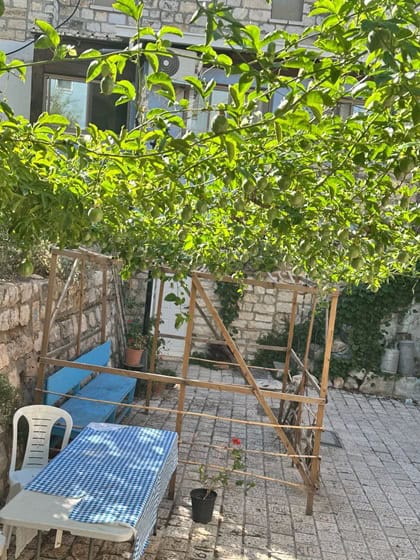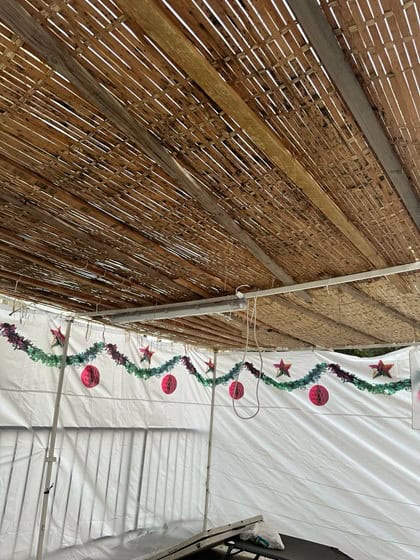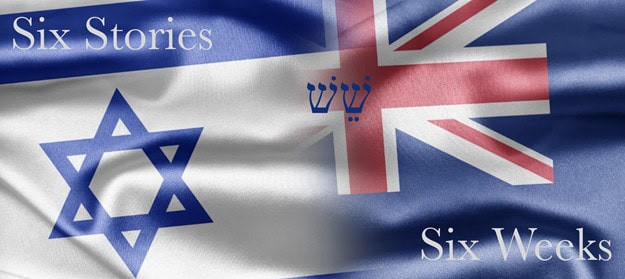By Mitch Kora and Miriam Bell…
One Community Chronicle correspondent Mitch Kora will be in Tzfat in Israel for Sukkot, and wanted to be involved in every aspect of the holiday.
She thought helping build a sukkah would be a good way to go about that. Here’s her story describing what she learnt…
Each Jewish holiday carries a unique spiritual message, and Sukkot, known as Z’man Simchateinu (“The Season of Our Joy”) stands out as a holiday of both celebration and introspection.
So what better idea, when in Tzfat, than to find a rabbi who is willing to build a sukkah with me and explain as we go.
Rabbi Shmu’el Zivan has been a rabbi in both Jerusalem and Tzvat for over 40 years and is up for the task.
“After a month of thought and repentance, Sukkot symbolises the joy of harvest, both physically and spiritually. In fact, Sukkot is the happiest of all the festivals” says Rav Zivan.
The Haga Asif (Festival of Ingathering) is when ancient Israelites would gather their harvest into their barns and rejoice at the success of their hard work, I discover.
“Similarily, we can celebrate the good deeds, prayers, and personal growth we’ve accumulated during the High Holidays,” Rav Zivan says.
Living in the sukkah
Central to the observance of Sukkot is the mitzvah of dwelling in the sukkah — a temporary hut with a roof made from natural materials, such as palm branches or bamboo.
Like many of the sukkot made locally, the walls do not matter, it is the ceiling/roof that is the most important.
Rav Zivan says the sukkah is not merely a ritual structure – it is a living symbol of faith.
“The sukkah is a symbol that natural protection is weak because you feel the wind, the rain, the sun. It’s not physical protection; the real protection comes from HaShem.”

[PHOTO: The sukkah we built…]
The four species: a symbol of unity
The night before Yom Kippur, we crammed into one of the many bomb shelters that had been temporarily turned into a “four species” shop operated by the local Biet Kenisit.
“The Arba Minim — the four species: the etrog (citron), lulav (palm branch), hadassim (myrtle), and aravot (willow) are not just random plants,” the Rabbi says. “They symbolize four types of Jews”.
- Etrog – with both taste and smell, represents those with Torah knowledge and good deeds.
- Lulav – taste but no fragrance, represents Torah knowledge without good deeds.
- Hadassim – fragrant but tasteless, represent good deeds without Torah learning.
- Aravot – neither taste nor smell, represent those lacking in both areas.
As we bind them all together in the sukkah, Rav Zivan explains the importance of unity — that every Jew, regardless of background or observance, has a place and purpose within the community.
What can we learn today?
In a world where people seek security in walls and certainty in control, Sukkot gently reminds us that life is fragile, and our true safety comes from above, he says.
“Sitting in a sukkah, open to the elements, we reconnect with what truly matters: faith, community, and purpose.
“The joy of Sukkot is not superficial. It’s a joy that comes from knowing we are protected, guided, and loved, even in the most vulnerable places. It’s a joy that strengthens us for the entire year to come.”
As we wave the four species and sit beneath the sukkah’s non-weather resistant roof, we do not just reenact ancient rituals.
Rav Zivan reminds us that “the sukkot calls us to step outside, embrace nature and most importantly, be joyous”.
What is the central message or purpose of Sukkot?
Because it is a divine holiday, everything which is divine has more than one message. We can learn by our sages, in the פילה (season) זְמָן (season) hotel lailu – the time of most joy.
It is the most joyous and happiest of all the holidays, and here’s what it involves:
- Sukkot is the end of two roads: מַסְל֣וּל masloon
- Mitzva for every family to come to Jerusalem in the Betta Midrash Temple.
- In the Torah, it’s an agricultural holiday.
- Peasach / shuvort / sukkot
- Spring / haga katseal – cut reap dried by the sun. Haga seaf: Jews take all the grain inside their homes in a barn; this is haga seaf.
- Harvest.
The spiritual meaning revolves around husidoot haga seaf (taking all your good deeds during the year); Rosh Hashanna (thinking about your role with hashem); and Yom Kippur (forgiveness to you leave behind your bad things so you are now left with the good).

[PHOTO: The sukkah at the shul…]
Who builds, eats, sleeps in a sukkah during the holiday?
It is about joy plus two big mitzvahs. Living in a sukkah is a very special mitzvah as we learn, and it elevates all of our lives, I learn.
The idea is that you relate to your sukkah like you do your house. Many people will eat meals, spend time with family and friends, and even sleep in the sukkah as a way to make it their temporary home.
How extensively a person uses their sukkah can vary greatly. While some will sleep there every night, others may only eat meals there… But it is fun!
What do you think the Jewish people can take away from Sukkot today?
Rav Zivan says Sukkot provides joy and happiness to give strength for the whole year.
Sukkot is between both, so you need to feel the wind and rain and sun – inside and outside at the same time, he says.
“The sukkah is a symbol that the natural protection is very weak because you can feel the elements, it’s not a physical protection, the real protection comes from HaShem.”
Read the introduction to Mitch Kora’s “Six Stories, Six Weeks” on the One Community Chronicle HERE.
Read Kora’s stories on how tourism is faring in Jerusalem and the wives of IDF reservists HERE and HERE.






